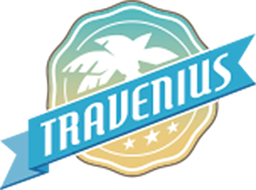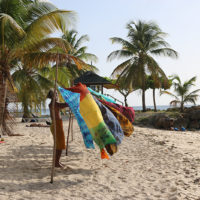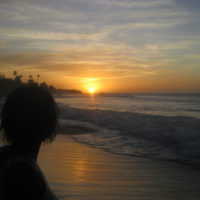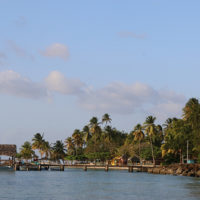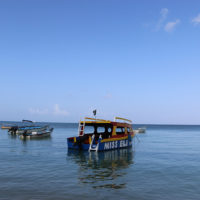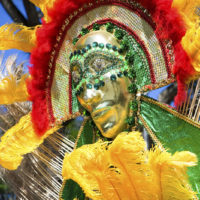Go to Cart 0,00 €
0
Trinidad & Tobago
General Information
Things to do
On the islands of Trinidad and Tobago there are many things to do to ensure you will not get bored. From the energetic Carnival celebrations - to some it is considered the largest and best street party in the world - to the north coast beach of Maracas Bay. Trinidad is also well known for having a wondrous geological formation called La Brea Pitch Lake. This lake is the largest of three natural asphalt lakes in the world.
Tobago is the smaller of the twin islands and only 20 minutes flying time away from Trinidad. Tobago offers even more scenic beaches from beach parties at Buccoo Sunday School to the secluded beaches of Pirate's Bay and everything in between. This little island is also known for its array of water sports and well known to have some of the best dive sites in the Caribbean. It is in fact home to the largest brain coral in the world. Find out more about the island's rich history, this cultural phenomenon called Carnival, diving, the island's flora and fauna and off the beaten path secrets in our guide books.
Transportation to and on the island
No matter if you are looking for a more energetic vacation in Trinidad or a laid-back yet fun filled vacation on Tobago... Many of the major airlines such as American Airlines, United Airlines, Caribbean Airlines, Air Canada and British Airways can get you there with regularly scheduled flights from major airports such as New York, Newark, Miami, Houston, Orlando, Ft Lauderdale Toronto and London. Condor offers a direct service from Frankfurt to Tobago.
Travel between Trinidad and Tobago is also quite efficient. Caribbean Airlines offers roughly 25 flights daily between the islands with a flying time of merely 20 minutes. The Port Authority of Trinidad and Tobago also has regularly scheduled ferry service daily between the islands with a travel time of 2 1/2 hours.
When you get there you first note that in both Trinidad and Tobago you drive on the left hand side of the road. For many it may seem odd however the driver also sits on the opposite side therefore it all comes together once you are behind the wheel of a car. The islands offer also a wide range of public transportation options such as government run buses, privately owned taxis and mini buses also knows as "Maxi Taxis". Therefore it is fairly easy to navigate your way through the islands.
Climate
“Tropical” best describes the climate of the twin islands. Because of the islands' location in relation to the equator and the northeast trade winds the temperature remains relatively pleasant. The annual average low is 26 °C (79 °F) with an average annual high of 33 °C (92 °F). Trinidad and Tobago experiences only two seasons, the wet or rainy season and a dry season. The dry season occurs during the months December to May and the wet season usually between June and October / November. Due to the islands’ location they are hardly or never hit by hurricanes as they lie just South of the Hurricane Belt.
Culture and History
The twin islands of Trinidad and Tobago have a rich history. The island of Trinidad was discovered by Christopher Columbus in 1498 who gave it the name La Trinity. However, prior to Columbus's discovery the island was inhabited by the Carib and Arawak Indians. After Columbus' discovery nearly a century passed before Trinidad became a colony of Spain. During this century Trinidad changed colonial hands many times. During the period 1889 - 1898 while under the British rule Trinidad merged governments with Tobago and in the year 1962 the islands gained independence from the British Crown to become the Republic of Trinidad and Tobago.
Trinidad and Tobago's multicultural history today truly lives up to the islands' motor "Every Creed and Race Finds an Equal Place". The beauty of these islands lies not only in the typical beach, sea, and surf, but in the energy of its people and their lust for life.
Carnival is a season of its own culminating in the celebrations on the days before Ash Wednesday. Whether you participate in J'Ouvert - also known as the "Dirty Mas" since participants cover each over in paint and mud on Carnival Monday morning or in the big parade on Tuesday's "Pretty Mas" - It is truely an exceptional experience and a great way to meet these friendly Caribbean people. Both islands are a perfect destination for a wide range of outdoor activities as well as cultural events and historic venues. Find out more about these beautiful islands historical sites, people and places in one of our guide books.
Geography
Trinidad and Tobago is the most Southern country in the Caribbean. The shortest distance between the Southwestern tip of Trinidad and the coast of Venezuela is less than 7 miles (11km). Tobago as the smaller island lies North West of Trinidad surrounded by the Caribbean Sea in the West and the Atlantic Ocean in the East. Trinidad has three mountain ranges with the highest point at 940 meters (3,084ft) above sea level. Outsides of these ranges rolling hills characterize the island while Tobago is considerably more rugged due to the volcanic nature of the island. Today there are no active volcanoes on Tobago though.
Interesting fact - Unlike its historic and cultural background and influences Trinidad belongs to the South American shelf and is - geologically - a part of South America.
